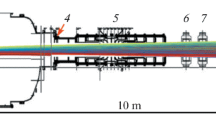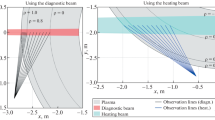Abstract
A conceptual design of a charge-exchange hydrogen atomic beam diagnostic injector for the TRT tokamak is presented. The injector is supposed to be used to measure the plasma parameters in the tokamak by active spectroscopy methods. In an ion source of the diagnostic injector, a ballistically focused ion beam is formed by a precision multi-aperture ion–optical system with four spherical electrodes. The plasma emitter is created by the hydrogen plasma from an arc generator or from a generator with an inductive RF discharge, expanding into a volume with a peripheral multipole magnetic field. The equivalent current of a beam of hydrogen atoms with an energy of 60 keV injected into the TRT plasma is ~4.5 A. At an angular beam divergence of ~7 mrad and a distance of ~9 m from the ion source to the center of the tokamak plasma, the diameter of the diagnostic beam in the measurement zone is ~13 cm at the level of 1/e. During the operating pulse of the TRT tokamak, several modulated pulses of the diagnostic beam of hydrogen atoms can be injected with a duration of ~1 s.
Similar content being viewed by others
Avoid common mistakes on your manuscript.
1 INTRODUCTION
At present, the design of a quasi-stationary tokamak with reactor technologies (TRT) [1] with a high magnetic field (up to 8 T) is underway. An increased magnetic field should ensure the achievement of thermonuclear regimes of the tokamak plasma at sufficiently small dimensions of the facility (R = 2.15 m, a = 0.57 m). TRT is designed to operate in quasi-stationary modes with hydrogen, helium and deuterium plasmas with an average density of up to 2 × 1020 m–3 and temperature of ~10 keV.
To determine the plasma parameters in the TRT, active spectroscopy methods on fast atom beams are used. These methods make it possible to measure the ion temperature, plasma rotation velocities and impurity concentration (CXRS diagnostics—Сharge eXchange Recombination Spectroscopy), plasma density fluctuations (BES diagnostics—Beam Emission Spectroscopy) and the current magnetic field profile according to the dynamic Stark effect (MSE diagnostics—Motion Stark Effect). A conceptual design of a diagnostic injector of fast hydrogen atoms for the TRT tokamak is being developed at the Budker Institute of Nuclear Physics, Siberian Branch, Russian Academy of Sciences (BINP). The development is carried out taking into account the experience on creating a series of rechargeable diagnostic injectors for fast atom beams for modern facilities with magnetic confinement of high-temperature plasma [2, 3]. The most suitable injector prototypes for TRT are a RUDI-X diagnostic injector for a W-7X large stellarator [4] and a DINA-KI60 diagnostic injector [5] for a T-15MD tokamak. Beams of fast hydrogen atoms of these injectors are designed for active spectroscopy measurements of impurities of the above set of physical parameters in a plasma column with a radius of 0.5–0.7 m. The injectors form focused beams of fast hydrogen atoms with an energy of 60 keV and an equivalent current of ~2.3–2.4 A. The ion source of the RUDI-X diagnostic injector uses a plasma RF emitter, and the ion source of the DINA-KI60 injector uses a plasma emitter with an arc plasma generator. In the RUDI-X diagnostic injector, the fast atom beam is ballistically focused at a distance of 6 m, and in the DINA-KI60 injector, at a distance of 4 m.
The work discusses the conceptual design of a diagnostic injector for the TRT tokamak, with an emphasis on fulfilling the requirements for CXRS diagnostics. The features of using the injector on the TRT tokamak are discussed, the location and layout of the injector are selected, the main parameters of the diagnostic beam are determined (only for CXRS), and design options for the ion source of the injector are considered.
2 DIAGNOSTIC INJECTORS OF THE BUDKER INSTITUTE OF NUCLEAR PHYSICS, SIBERIAN BRANCH, RUSSIAN ACADEMY OF SCIENCES
A feature of modern diagnostic injectors of the BINP is the use of ballistic focusing of the ion beam due to the spherical shape of the electrodes of a multi-aperture four-electrode ion-optical system. The scheme of ballistic beam focusing is shown in Fig. 1. The emission current density in the ion–optical system is chosen to be sufficiently low of ~110–130 mA/cm2, which is several times lower than the emission current density in ion–optical systems of powerful injectors for plasma heating. The plasma emitter in the ion sources of diagnostic injectors is created by hydrogen plasma from an arc generator, or from a generator with an inductive RF discharge, expanding into a volume with a peripheral multipole magnetic field. At a reduced emission current density, the gaps between the electrodes of the ion–optical system corresponding to the optimal beam formation are sufficiently large, which leads to a decrease in aberrations in individual cells of the ion–optical system and a decrease in the angular divergence of individual beams δα to 8–10 mrad. When the beam is focused to a di-stance F, the atomic flux profile in the focus is expressed as j(r, F) = Ibexp(–r 2/(δαF)2)/(πδαF)2, where Ib is total flow of atoms in the beam.
Diagnostic injectors of BINP with a long pulse duration are equipped with elements for obtaining and transporting a fast atom beam. As an example, Fig. 2 shows the scheme of the RUDI injector for the TE-XTOR-94 tokamak [2]. The ion source is on the left, then the vacuum chamber of the injector with auxiliary systems, the plasma cross section in the tokamak is shown on the right. The focus of the diagnostic beam is 4 m away from the ion source and is located near the center of the plasma. In the vacuum chamber of the injector, there are located water-cooled elements: a neutralizer, a magnetic ion separator, a deflected ion receiver, and a movable calorimeter. The neutralizer channel is partially filled with gas flowing out of the gas discharge chamber of the ion source, and additional puffing is carried out by a pulsed gas valve. The magnetic separator and the receiver of non-recharged ions are installed inside the vacuum volume on a special platform. Two-stage differential pumping of the vacuum volume is carried out by powerful cryopumps.
3 SELECTION OF THE PARAMETERS OF THE DIAGNOSTIC INJECTOR FOR THE TRT TOKAMAK
The TRT tokamak plasma has a sufficiently high density, which leads to a noticeable attenuation of the diagnostic beam. In [6], a full-scale simulation of the CXRS diagnostics was carried out taking into account the following parameters of the diagnostic beam and beam attenuation in plasma, and it was shown that the diagnostics works well on the diagnostic beam of the TRT tokamak with an energy of 60 keV in a plasma with an average density of ne = 1 × 1020 m–3. At ne = 2 × 1020 m–3, the measurements at the center of the plasma are possible, but at such a density, the measurement error increases.
The TRT tokamak has rather long ports, so the distance from the injector to the center of the plasma is about 9 m. At such a distance and an angular beam divergence of ~7 mrad, the beam diameter (at the level of 1/e) at the center of the TRT plasma is ~13 cm. The diagnostic beam diameter in the TRT plasma exceeds the beam diameter of the DINA-KI60 diagnostic injector in the T15-MD tokamak plasma. An increase in the beam diameter while maintaining the flow of atoms leads to a decrease in the integral linear density of the diagnostic beam along the line of observation. To increase the linear density, it is necessary to increase the flux of fast atoms; therefore, in the TRT diagnostic beam, the equivalent current of hydrogen atoms with an energy of 60 keV is increased to 4.5 A. The total current of hydrogen ions from the ion source of the injector at the composition of the beam according to the ion current of Н+ : \({\text{H}}_{2}^{ + }\) : \({\text{H}}_{3}^{ + }\) = 85% : 10% : 5% is 12 А.
Figure 3 shows the scheme of active plasma spectroscopy in the chamber of the TRT tokamak (top view). The diagnostic beam of hydrogen atoms is injected into the plasma through an equatorial radial nozzle. The diagnostic beam and the optical system for collecting light are located in the equatorial plane of the plasma. The viewing area of the optical system is located between the beam input into the plasma and the center of the plasma. The optical system for collecting light is located inside the neighboring radial equatorial nozzle. The spatial resolution along the radius for the selected scheme of active spectroscopy is ~1–5 cm [6].
An important issue is the transportation of the diagnostic beam through a long injection port. When an intense beam of fast atoms passes through a long port, beam blocking can occur [7]. A sufficiently strong magnetic field in the nozzle area deflects the ions formed as a result of stripping onto the wall. Bombardment of the nozzle wall with fast ions leads to the release of sorbed gas, which increases its density in the port and causes a further increase in beam ionization. Such a process is avalanche-like and the critical equivalent beam current, above which an avalanche develops in the nozzle, is expressed as follows: Icrit ≈ Ceffe/(γLσ01), where Ceff is the effective gas conductivity of the path, γ is the gas desorption coefficient, σ01 is the stripping cross section of fast hydrogen atoms. For a rectangular TRT injection port with an internal cross section of 60 × 100 cm and a length of 420 cm at a desorption coefficient γ ≈ 3 corresponding to a path without special wall treatment, the critical equivalent beam current for adsorbed hydrogen is estimated at ~110 A. This value is much larger than the atomic flux in the diagnostic beam, but it should be taken into account that deuterium and heavier gases can be adsorbed on the walls of the nozzle.
4 VARIANTS OF THE ION SOURCE OF THE DIAGNOSTIC INJECTOR
The diagram of the ion source of the DINA-KI60 diagnostic injector is shown in Fig. 4. The plasma emitter in the ion source is created by a jet of hydrogen plasma from an arc generator, expanding into a volume with a peripheral multipole magnetic field. A ballistically focused ion beam is formed by a multi-aperture four-electrode ion–optical system. The generated hydrogen ion beam has a current of 6 A, an energy of 60 keV, an angular divergence of 8.5 mrad, and a focal length of 4 m. This source can be modified for the TRT diagnostic injector. To increase the beam current from the source, the emission diameter should be increased to 18 cm, which requires an increase in the diameters of the plasma emitter and the ion–optical system.
The beam is formed by a multi-aperture four-electrode ion–optical system with round apertures. An optimized calculation version of a separate cell of an ion–optical cell with quasi-Pierce chamfers on the plasma electrode is shown in Fig. 5. At an optimal hydrogen ion current density of 120 mA/cm2, the angular divergence of an individual beam is 6.5 mrad. When using slit apertures instead of round holes, it is possible to reduce the angular divergence in the direction along the slits, since there is no aberration along the slits and the divergence is determined only by the temperature of the plasma emitter ions. When replacing round apertures in the RUDI diagnostic injector with slit ones, the angular divergence along the slits decreased by 20% [8]. Narrowing the diagnostic beam in the direction along the slits increases the intensity of the active signal from the TRT plasma.
The elements of the discharge channel of the arc generator are eroded and require replacement after about a year. To increase the service life of the plasma emitter, it is advisable to use an inductive RF driver instead of an arc generator. In [9], a plasma emitter with an RF driver and an expander is presented. In this emitter, the hydrogen ion current density is 120 mA/cm2 and the proton content is at the level of 80% inside the emission diameter of 16 cm.
The total duration of the beam pulse, 10 s, is mainly limited by the increase in the temperature of the electrodes of the ion–optical system. The electrodes of the ion–optical system do not have channels for intensive water cooling and the cooling of the electrodes occurs in an inertial way. During the formation of the beam, the increase in the temperature of the electrodes is limited by the heat capacity of the electrodes, and after the end of the formation of the beam, the heat from the electrodes is transferred to the water-cooled holders. This cooling method limits the total duration of pulses modulated with a duty cycle of 0.5 during the TRT pulse to 10 s. Note that such a duration of the modulated beam pulse was experimentally obtained using the RUDI diagnostic injector with a plasma emitter based on an arc generator.
In the arc plasma generator, the anode and cathode are intensively cooled by water, and the temperature of the diaphragms of the discharge channel is limited by the heat capacity and peripheral water cooling. In a plasma emitter based on an RF discharge, the antenna, chamber walls, and Faraday shield are water-cooled. At present, plasma emitters with a pulse duration of 20 s have been developed and experimentally tested.
5 LOCATION OF THE DIAGNOSTIC INJECTOR AT TRT
Figure 6 shows the location of the diagnostic injector on the TRT. The diagnostic injector is connected to the equatorial radial port of the TRT. The view of the vacuum chamber of the diagnostic injector with the pumping system and elements of the beam path in the figure is taken from the 80-keV, 1-MW injector of a focused beam of fast deuterium atoms for plasma heating recently developed at the Budker Institute of Nuclear Physics, Siberian Branch, Russian Academy of Sciences. It is assumed that the design of the vacuum chamber of the diagnostic injector for the TRT with the pumping system and elements of the beam path, developed later, is close to the corresponding design of this injector for plasma heating.
The ion source and neutralizer should be shielded from the scattered magnetic field of the TRT. In the region of the injector, the magnetic field from the TRT tokamak is mainly generated by the plasma current and poloidal coils. This field has a vertical direction and its strength is 15–30 mT. Such a magnetic field can be shielded with double magnetic screens. The outer screen is steel, the inner one is made of annealed permalloy. Table 1 shows the main parameters of the diagnostic injector for the TRT tokamak.
6 CONCLUSIONS
The presented conceptual design of the diagnostic injector of the focused hydrogen atom beam for the TRT tokamak seems to be quite feasible. Further work on the injector project can consist in refining the parameters of the diagnostic beam for measurements on the basis of the dynamic Stark effect, detailed development of the ion source, optimization and design of the injector elements, selection of power supply and control systems, and experimental studies of beam formation and transport. To increase the beam current density in the measurement zone, it is necessary to consider the possibility of reducing the distance between the ion source of the injector and the TRT tokamak plasma.
REFERENCES
A. V. Krasilnikov, S. V. Konovalov, E. N. Bondarchuk, I. V. Mazul, I. Yu. Rodin, A. B. Mineev, E. G. Kuz’min, A. A. Kavin, D. A. Karpov, V. M. Leonov, R. R. Khayrutdinov, A. S. Kukushkin, D. V. Portnov, A. A. Ivanov, Yu. I. Belchenko, et al., Plasma Phys. Rep. 47, 1092 (2021). https://doi.org/10.1134/S1063780X21110192
Yu. I. Belchenko, V. I. Davydenko, P. P. Deichuli, I. S. Emelev, A. A. Ivanov, V. V. Kolmogorov, S. G. Konstantinov, A. A. Krasnov, S. S. Popov, A. L. Sanin, A. V. Sorokin, N. V. Stupishin, I. V. Shikhovtsev, A. V. Kolmogorov, M. G. Atlukhanov, et al., Phys.–Usp. 61, 531 (2018). https://doi.org/10.3367/UFNe.2018.02.038305
V. I. Davydenko and A. A. Ivanov, Rev. Sci. Instrum. 75, 1809 (2004). https://doi.org/10.1063/1.1699461
V. Davydenko, P. Deichuli, A. Ivanov, N. Stupishin, V. Kapitonov, A. Kolmogorov, I. Ivanov, A. Sorokin, and I. Shikhovtsev, AIP Conf. Proc. 1771, 030025 (2016). https://doi.org/10.1063/1.4964181
N. V. Stupishin, P. P. Deichuli, A. A. Ivanov, A. G. Abdrashitov, G. F. Abdrashitov, V. V. Rashenko, P. V. Zubarev, A. I. Gorbovsky, V. V. Mishagin, V. A. Kapitonov, V. A. Krupin, and G. N. Tilinin, AIP Conf. Proc. 1771, 050012 (2016). https://doi.org/10.1063/1.4964206
S. V. Serov, S. N. Tugarinov, V. V. Serov, V. A. Krupin, I. A. Zemtsov, A. V. Krasil’nikov, N. V. Kuz’min, G. S. Pavlova, and N. N. Naumenko, Plasma Phys. Rep. 48, 844 (2022).
A. C. Riviere and J. Sheffield, Nucl. Fusion 15, 944 (1975). https://doi.org/10.1088/0029-5515/15/5/024
A. Listopad, J. Coenen, V. Davydenko, A. Ivanov, V. Mishagin, V. Savkin, B. Schweer, G. Shul’zhenko, and R. Uhlemann, Rev. Sci. Instrum. 83, 02B707 (2012). https://doi.org/10.1063/1.3669794
I. V. Shikhovtsev, I. I. Averbukh, A. A. Ivanov, V. V. Mishagin, and A. A. Podyminogin, Fusion Eng. Des. 82, 1282 (2007). https://doi.org/10.1016/j.fusengdes.2007.04.048
ACKNOWLEDGMENTS
We are grateful to A.V. Brul for performing simulations of the cell of the ion–optical system and to S.N. Tugarinov for helpful discussions.
Author information
Authors and Affiliations
Corresponding author
Ethics declarations
The authors declare that they have no conflicts of interest.
Additional information
Translated by L. Mosina
Rights and permissions
About this article
Cite this article
Davydenko, V.I., Ivanov, A.A. & Stupishin, N.V. Conceptual Design of Diagnostic Hydrogen Beam Injector for TRT Tokamak. Plasma Phys. Rep. 48, 838–843 (2022). https://doi.org/10.1134/S1063780X22600529
Received:
Revised:
Accepted:
Published:
Issue Date:
DOI: https://doi.org/10.1134/S1063780X22600529










